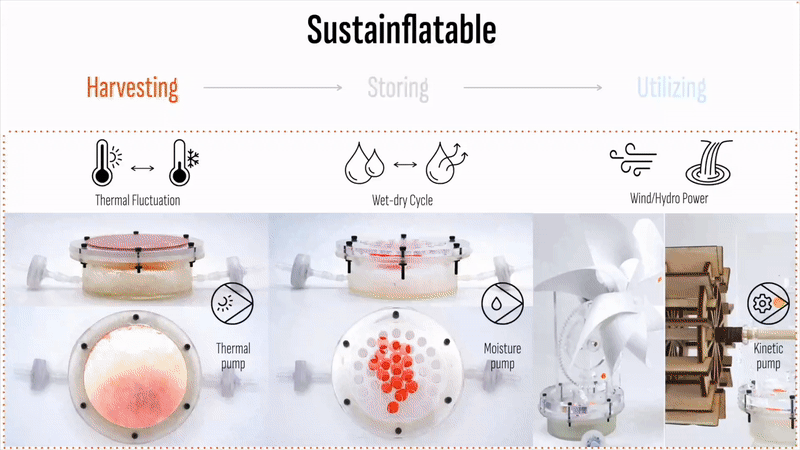2023
Qiuyu Lu, Tianyu Yu, Semina Yi, Yuran Ding, Haipeng Mi, Lining Yao
🏅️ Honorable Mention
While the majority of pneumatic interfaces are powered and controlled by traditional electric pumps and valves, alternative sustainable energy-harnessing technology has been attracting attention. This paper presents a novel solution to this challenge with the development of the Sustainflatable system, a self-sustaining pneumatic system that can harvest renewable energy sources such as wind, water flow, moisture, and sunlight, convert the energy into compressed air, and store it for later use in a programmable and intelligent way. The system is completely electronic-free, incorporating customized energy harvesting pumps, storage units with variable volume-pressure characteristics, and tailored valves that operate autonomously. Additionally, the paper provides a design tool to guide the development of the system and includes several environmental applications to showcase its capabilities.
Contributions:
- Developed a computational method (iterative quasi-static method) to model and predict the system’s programmable inflating responses to long-term environmental changes. Developed a GUI design and simulation tool.
- Designed the 3D models of the pumps, valves, and the molds for casting silicone bi-stable membranes. Conducted the experiments to evaluate the performance of the bursting valve with bi-stable membranes.
Design space
To achieve the goal of harnessing ambient energy for a pneumatic interface, we propose a three-phase solution. Firstly, we employ various non-electric pumps that can harvest a variety of ambient energy sources and leverage this energy to compress air. We then utilize storage units with distinct volume-pressure characteristic curves to store the compressed air. Finally, we incorporate various non-electric valves that are triggered by environmental factors with tunable thresholds to manage the compressed air.

The three-phase energy harnessing solution provided by Sustainflatabe
Pumps

Thermal pump: leverage temperature fluctuations to compress air

Moisture pump: utilize dry-wet cycles to compress air

Kinetic pump: use mechanical energy such as wind or hydro energy to compress air
Valves

Thermal valve: respond to ambient temperature (two types: normally closed or normally open)

Moisture valve: be triggered by the dry-wet cycle

Bursting valve: respond to air pressure and either open or close accordingly
Storages

Three types of storage: sample rigid, low elastic, and highly elastic storage. (a) The relation of “volume of compressed air pumped in” and pressure. (b) The dimension of the tested samples.
Application examples
The Sustainflatable system is designed to be versatile and adaptable, making it suitable for deployment in various settings, whether indoors or outdoors. It is also autonomous, meaning that it does not require constant human intervention or monitoring. We present several examples of how the system can be used in a backyard garden context. These concepts serve to illustrate the potential of our technique and inspire HCI researchers and designers to develop even more innovative and sophisticated applications in a wide range of scenarios.




Design tools
We developed a design tool to guide users through the design and fabrication process of Sustainflatable system. The design tool enables the users to explore different configurations and structures of the system with a simple GUI. It also provides a preview of the system’s working procedure reacting to the environment changes, which will helps users better understand and iterate the function of the designed system. Lastly, the tool can export corresponding model and material list to facilitate prototyping of the system. We developed the design tool on Rhino 7 Grasshopper platform. We introduced the user workflow and implementation in the following sections.

Simulation implementation
Further detials: Sustainflatable: Harvesting, Storing and Utilizing Ambient Energy for Pneumatic Morphing Interfaces (ACM UIST ’23)
